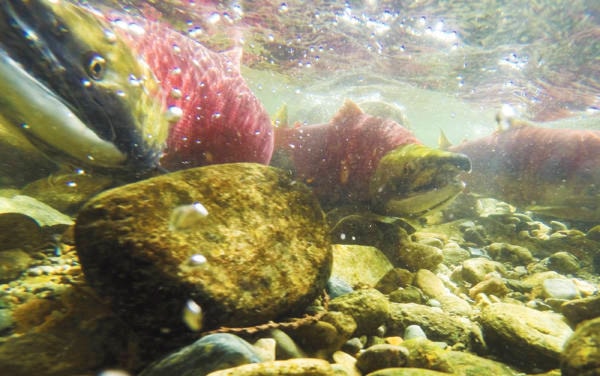B.C.’s Wild Salmon Advisory Council will bypass Terrace and all other inland communities with salmon-bearing rivers during this month’s series of public engagement sessions.
The sessions are necessary for the council to receive feedback from stakeholders on recommendations they’ve put forward to the government on better managing wild salmon stocks.
Five coastal communities will be visited this month, with another two or three next month. The January dates and locations have yet to be decided, but the advisory council’s secretariat, Allison Witter, says fresh-water locations like Terrace will likely not make the list.
“We will make it to Prince Rupert, but whether we make it inland remains to be seen…it’s doubtful,” she says.
“We recognize there are multiple perspectives we want to hear, but we’re only going to make it to a handful of communities because we’re on a really tight schedule with the holidays. We are encouraging people to submit their feedback online.”
The Wild Salmon Advisory Council consists of 14 British Columbians who the province describes as having a broad understanding of the role that salmon play within B.C.’s environment.
Bob Hooton, a retired biologist and former B.C. Ministry of Environment fisheries-section head for the Skeena region, says he isn’t surprised to learn the council is visiting only coastal communities for its engagement sessions.
“There are no fresh-water interests whatsoever represented within that group. It’s a complete shutout. It’s so heavily weighted towards the commercial industry and unions [and First Nations fisheries] that the recreational guys are left out completely.”
READ MORE: Anglers furious over VIP fishing trip
There are three members with sports fishing backgrounds on the council, but Hooton says the most influential among them, Martin Paish, a director of the Sport Fishing Institute of British Columbia, largely represents the salt-water commercial-recreational industry.
Paish could not be reached for comment, but Owen Bird, also a director of the institute, says the poor representation highlights the general confusion surrounding the council’s mandate.
“What exactly is it?” he asks. “If it’s in the interest of working with small coastal communities and the impacts of salmon fisheries to them, it might be a good indicator of why there is a lack of good representation from interior locations — and even in some cases the lack of academics.
“There’s a very lively sports fishing community and activities that take place inland, well beyond tidal waters. So that question is still outstanding…what exactly is the council’s purpose?”
According to the government website, the Wild Salmon Strategy must include options for the restoration and enhancement of wild salmon populations; sustainable fisheries management and stewardship opportunities for communities; and new economic development opportunities to assist viable community-based fisheries.
Skeena MLA Ellis Ross says that the agenda ties neatly into the economical and social landscape of inland communities, but at the end of the day “no one cares about the inland fisheries.”
“If you’re not going to come and consult on the Skeena River, or the Kitimat River, which are some of the biggest [angling] tourism draws around the world, then we’re getting ignored the same way Ottawa ignores us.”
Going forward, Ross hopes stakeholders in the recreational and First Nations fisheries will present a unified voice to policy makers, demanding more inclusion on management decisions.
“It’s got to be a collective. Everything else I’ve seen has been people acting on their own and what ends up happening is we fight each other for scraps.”
A study released last year by Big River Analytics in Terrace found the annual domestic output from guided fishing in the Lower Skeena reached $16.5 million in 2016.
READ MORE: Tourism coalition pushing for Skeena chinook fishery
In a catch and release environment, the in-river fishery generates the highest per-fish economic contribution to the province and has the lowest exploitation rates. The numbers leave Hooton bewildered at why the region doesn’t get more attention in policy-making initiatives like the Wild Salmon Strategy.
“If there’s a sunset industry in this province, it’s the commercial fishing industry,” says Hooton. “The value of a chinook to the commercial industry these days is essentially negligible. But the value of that same fish to the recreational sector is enormous.”
The Prince Rupert public engagement session will take place Dec. 17 from 6 to 8 p.m. at the Jim Ciccone Civic Centre. Registration opens at 5:30 p.m.
For a list of all B.C. sessions, or to read the Options Paper and submit feedback visit the provincial government’s website at
engage.gov.bc.ca/bcwildsalmonstrategy
quinn@terracestandard.com
Like us on Facebook and follow us on Twitter
